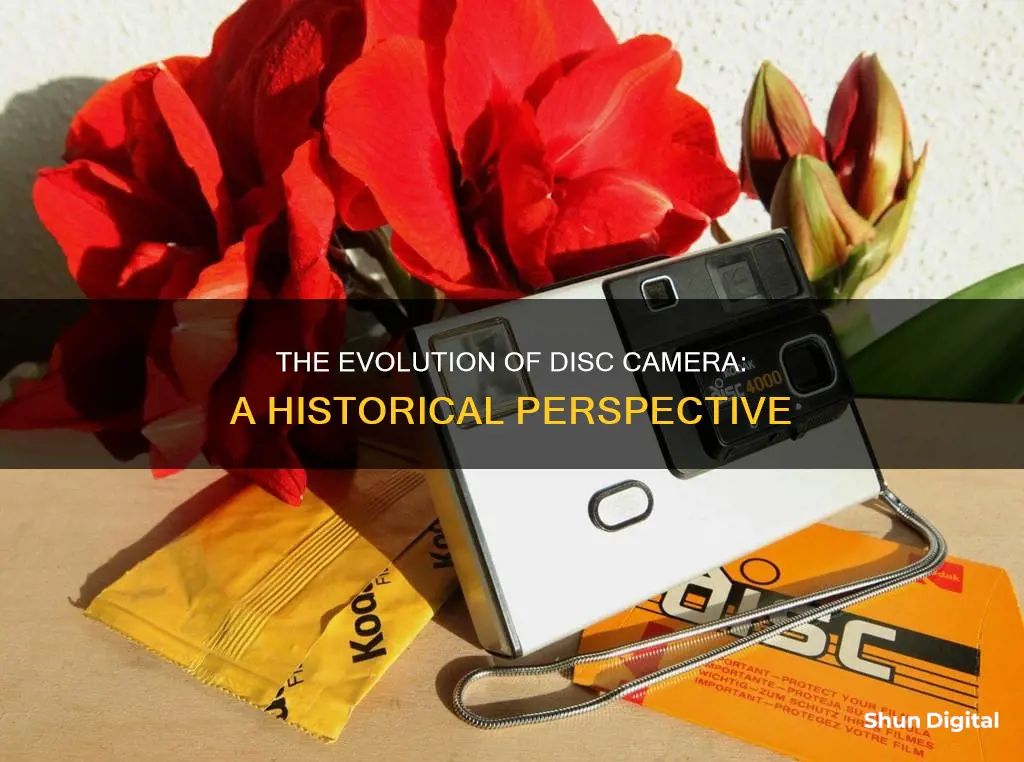
The disc camera was introduced in 1982 by Kodak. The camera was lightweight, foolproof, and affordable. It used a new kind of film cartridge, with film mounted on a disc, instead of the traditional type of film that was spooled in a cartridge. Kodak's disc camera was an immediate hit, with the company selling 25 million units. However, the company pulled the plug on the camera by early 1988 due to poor sales, largely because of the rising popularity of 35mm cameras and the poor picture quality of the disc camera.
| Characteristics | Values |
|---|---|
| Date of Introduction | February 1982 |
| Company | Kodak |
| Film Format | Disc film |
| Film Size | 10x8mm |
| Number of Exposures | 15 |
| Film Type | Color-print negatives |
| Film Manufacturers | Kodak, Konica, Fuji, 3M |
| Camera Models | 4000, 4100, 6000, 8000, Tele Disc |
| Camera Features | Auto-exposure, built-in flash, motorized film advance |
| Production Years | 1982-1988 |
| Film Discontinuation | 1999 |
What You'll Learn

The Kodak Disc camera was introduced in 1982
The Kodak Disc camera was also packed with cutting-edge technology and innovative features. The camera was fully automated, with auto-exposure, auto-rewind, and a built-in flash. The flash would turn on automatically when the camera's sensors indicated that the light level needed a boost, and the batteries were guaranteed to work for five years or 2,000 exposures. The camera also featured a tiny motor winder that advanced the film to the next frame after each shot.
The Kodak Disc camera was also designed to be sleek and compact. The thin cartridge size meant that the camera itself was slim and could fit in a pocket. The camera was about 4-3/4 inches long, 3 inches high, and 7/8 inch thick, and weighed around six to seven ounces.
Despite its innovative features and compact design, the Kodak Disc camera ultimately failed to live up to its promise. The main issue was the poor picture quality, due to the small size of the negatives. The negatives were only 10mm by 8mm, which resulted in grainy prints with poor colour and definition. While Kodak developed special lenses for the cameras and printing equipment, many photo labs chose not to invest in this equipment and instead used standard lenses designed for larger formats. This further exacerbated the issue of poor picture quality.
In addition to the image quality issues, the Kodak Disc camera was also relatively expensive compared to other formats, and there were reports of reliability problems. As a result, the camera quickly fell out of favour, with production stopping in 1988, although Kodak continued to manufacture the film until 1999.
The Ultimate Guide to NVR Camera Battery Replacement
You may want to see also

It was lightweight, affordable, and automated
The Kodak Disc camera was introduced in 1982. It was a new generation of snapshot cameras that used a disc of film with 15 small film frames radiating from a central hub. The disc was mounted in a light-proof cassette that could be dropped into the camera. The camera would then rotate the disc 24° for each subsequent shot.
The cameras were lightweight, affordable, and automated. They were small enough to fit in the palm of your hand and could fit into many different pocket shapes. They weighed around six to seven ounces on average. The Kodak Disc camera was simple and convenient to use, with a fully automated system. The camera would wind and rewind the film, decide whether to use the flash, and advance the film to the next frame after each shot. The flash would turn on automatically when the sensors indicated that the light level needed a boost, and the batteries were guaranteed to work for five years or 2,000 exposures. The camera also featured a tiny motor winder that advanced the film to the next frame after each shot.
The Kodak Disc camera was a precursor to today's digital point-and-shoot cameras. It was thin, sleek, and automated, with features such as auto-exposure, auto-rewind, and auto-load. The short focal length of about 12.5mm put everything from four feet away and beyond in focus, so the user didn't have to worry about focusing the camera for each shot. The camera also offered a flash that turned on automatically when there wasn't enough light, which provided enough light to expose negatives for up to 18 feet. The shutter speeds were limited to 1/100 and 1/200, reducing the chance of blurring when the subject or camera moved.
The Kodak Disc camera was designed to be easy to use, even for novice photographers. The film was mounted on discs, and the camera did most of the work for the user. The innovative design and cutting-edge technology made it an immediate hit, and Kodak sold 25 million of these cameras. However, the small negative size of 10mm x 8mm proved to be a disadvantage, resulting in poor picture quality.
Why You Should Try Manual RAW Photography
You may want to see also

It had poor picture quality due to small negatives
The Kodak Disc camera was introduced in 1982. It was a lightweight, foolproof camera with auto-exposure and a built-in flash. It was also affordable and used a brand new kind of film cartridge. However, despite its initial popularity, it had poor picture quality due to its small negatives.
The negatives on the disc film were only 10mm by 8mm, which was significantly smaller than the already small 13mm by 17mm frames of 110 film. This small negative size led to unacceptable grain and poor definition in the final prints, especially when printed with standard three-element lenses instead of the special six-element lenses from Kodak. The images were often grainy, with poor colour and a lack of definition.
The small size of the negatives also meant that the image had to be greatly enlarged for a standard-sized print, which further reduced the picture quality. The negatives were about the size of a nail on the little finger, and when enlarged, the images often became grainy and lacked definition. This was a significant disadvantage compared to other cameras of the time, which were able to produce much better-quality images.
The poor picture quality was a major factor in the decline of the disc camera's popularity. By the early 1980s, newer 35mm cameras had become more popular, as they offered much better image quality and more automation, along with a choice of film types. While the disc cameras were thinner and more compact, the 35mm cameras provided superior image quality, which was more important to consumers.
In addition to the small negative size, there were other factors that contributed to the poor picture quality of disc cameras. One issue was the processing of the film. The manual nature of processing colour negative film at the time made it difficult to get the best results from the small negatives. The process was mostly manual, and photo labs often used equipment designed for larger formats, rather than investing in Kodak's specialised system. This further contributed to the poor picture quality associated with disc cameras.
The Evolution of Camera Lenses: Glass and Beyond
You may want to see also

Kodak discontinued the camera in 1988
The Kodak Disc camera was introduced in 1982 with a great deal of excitement. The camera was lightweight, easy to use, and affordable. It was also the first to use a brand new kind of film cartridge. The film was mounted on a disc that looked like a View-Master reel, instead of the traditional type of film that was spooled in a cartridge.
However, the Kodak Disc camera failed to deliver on its promise. The negatives were only 8mm x 10.5mm in size, which led to poor picture quality. The prints often turned out to be grainy, with poor colour and definition. This was largely due to the fact that photo labs chose not to invest in the specialty equipment required to get the best results from the disc film. Instead, they used the same machines that printed from other types of film.
In addition to the quality issues, the Kodak Disc camera was also relatively expensive compared to other formats that offered better image quality. Newer 35mm cameras provided much better images and more automation, along with a choice of film types.
As a result of these factors, the Kodak Disc camera quickly fell out of favour. Kodak stopped production of the camera in 1988, although the company continued to manufacture the film for another decade.
The discontinuation of the Kodak Disc camera can be attributed to a combination of factors, including poor picture quality, high cost, and the emergence of superior alternatives. The camera's failure serves as a reminder that even innovative products with strong initial demand can falter if they do not meet customer expectations and keep up with technological advancements.
The First Motion Camera: A Historical Perspective
You may want to see also

Kodak continued to make film for the camera until 1999
The disc camera was introduced by Kodak in 1982. The camera was lightweight, affordable, and used a brand new kind of film cartridge. The film was mounted on a disc that looked like the old View-Master reels. Kodak's intention was to develop the Instamatic idea of foolproof loading and simple operation into cameras that would work in all lighting conditions.
The disc camera was unsuccessful due to the poor quality of pictures it produced. The negatives were only 8mm by 10mm in size, resulting in generally unacceptable grain and poor definition in the final prints. The camera was discontinued in 1988, but Kodak continued to manufacture the film until 1999.
The film was officially discontinued by Kodak, the last manufacturer, on December 31, 1999. Kodak had produced films throughout the complete lifespan of the format. However, other manufacturers such as 3M, Konica, and Fuji also produced disc film. Kodak's decision to continue making the film for over a decade after the camera's discontinuation was likely due to its commitment to its customers and the existing user base of the camera.
The disc camera's failure was also attributed to the relative expense of the cameras compared to other formats and reliability problems. Newer 35mm cameras offered better image quality, more automation, and a choice of film types at a lower price point. Despite the disc camera's thin and compact design, consumers opted for the improved performance of bulkier models.
Kodak's decision to continue manufacturing the disc film for over a decade after the camera's discontinuation can be seen as a testament to the company's dedication to its customers and the existing user base of the camera. However, with the emergence of newer and better technologies, the demand for the disc film gradually declined, leading to its eventual discontinuation at the end of 1999.
Mastering the Art of Scaling Down in Camera Raw
You may want to see also
Frequently asked questions
The disc camera was introduced in 1982 by Kodak.
The negatives were about 10mm x 8mm.
The main issue with the disc camera was the poor picture quality due to the small size of the negatives. This led to grainy prints with poor colour and definition. There were also issues with reliability and the cameras were relatively expensive compared to other formats.
Kodak stopped production of the disc camera in 1988 due to poor sales, although they continued to manufacture the film until 1999.







